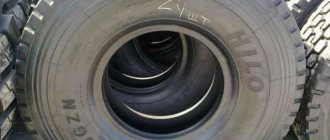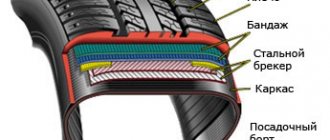Modern tires have a certain type of tread pattern. This pattern can be: non-directional, directional and asymmetrical. Thanks to this variety, sometimes you can get into an unpleasant situation when the car, for unknown reasons, starts to drive to the right or left, while the wheel alignment is set correctly. In this situation, most likely, during the next “change of shoes” from summer to winter or from winter to summer, the wheel was installed incorrectly. How to determine the direction of tire rotation in order to avoid such situations? You will find the answer in this article.
The importance of directional tire installation for different tread types.
So, as noted earlier, tires can have a non-directional, directional and asymmetrical pattern.
It is this pattern that determines the requirements of tires for directional installation:
- non-directional tires, by the way, the most budget option, work equally in any direction of rotation;
- asymmetrical - require careful installation, since such tires have a strictly defined direction of rotation - internal (indicated on the tire by the word “ins>
That is why the question of the direction of tire rotation is most relevant for owners of tires with a directional tread pattern. Fortunately, today almost all manufacturers put “hints” on their tires: large arrows are drawn on their sidewalls, which precisely indicate the required direction of rotation. Although there may be only one arrow, then the word “Rotation” will be present next to it.
If they are not there, know that tires with a “herringbone” should be installed so that the top of this herringbone touches the road first when rotating, that is, it looks in the direction opposite to the movement of the car.
Please note that in some cases there are tires that have both an asymmetrical and directional tread pattern. They should be installed according to generally accepted markings.
If you encounter difficulties in determining the direction of tire rotation, do not hesitate to consult specialists who will help you understand all the nuances and also provide more accurate information on this issue.
Approach the issue of installing tires competently and wisely, because your safety depends on it!
Source autoepoch.ru
The modern tire industry is creating its products better and better. Universal products are able to feel great on dry asphalt, drain water, provide traction, and in addition, provide acoustic comfort and reduce fuel consumption.
For modern cars, many sets are offered with a variety of treads and mixture compositions. This versatility has one drawback. The tread pattern differs between the halves of the tire. Therefore, there are Rotation, Inside or Outside marks on the tires, indicating the correct direction of rotation.
In this article we will talk about marking the direction of tire rotation, types of rubber, directional and non-directional tread patterns, and also tell you about all the pros and cons of such products.
What is rotation on tires
The main factor to pay attention to is the tire tread. A well-chosen pattern will maximize the contact patch with the road and help drain water and slush, preventing rubbing. Wheels come in both directional and non-directional patterns or asymmetrical structure. They differ in technical characteristics, production costs and recommended conditions of use.
A set with a symmetrical non-directional tread is considered universal. In addition, the technological process for producing such tires is much simpler than special tires, which has a positive effect on the price. In addition, it is easy to install tires with such a tread, because it is impossible to mix up the seats.
However, this pattern does not provide maximum tire-road contact in adverse weather conditions. This solution is a compromise. It is better to use universal tires as a spare tire
, which can easily fit into any place, but not as an everyday option.
Directional tires have their own pattern, which allows them to more effectively drain water and resist hydroplaning. The performance compared to a tire with a non-directional pattern is much higher. However, if they are installed incorrectly, the tread grooves will, on the contrary, draw in drops. Therefore, it is important to install such tires correctly.
These wheels have their own designation in the form of the Latin word Rotation. The direction of movement is indicated by the corresponding arrow. The disadvantage of such tires is that the wheels can only be placed on a certain side without removing them from the rim due to the fact that the tread pattern varies. If you want to put the left wheel on the right side, you need to remove the tires.
Consequences of rapid tire wear
Before we talk about the most important rules for operating and storing tires, let's talk about the reasons for such attention to the condition of the rubber. Although the tires on the wheels or rims of a car can be replaced relatively easily at any time, the safety of the car owner and his passengers depends on choosing the right tires and proper care:
- the size and dimensions of the tires must correspond to the manufacturer’s specifications - otherwise, you will encounter unpredictability in driving, rapid failure of tires and other components of the car;
- increased tire wear significantly worsens road grip, which leads to unpredictable consequences when driving;
- if worn tires are also used outside the regulated season, they will practically not be able to help in overcoming snow or ice, puddles, etc.
It is extremely difficult to determine the degree of tire wear by eye. Naturally, if as a result of use the outer protector has been completely worn out or damaged, even an inexperienced driver will notice it. However, in most cases, only tire specialists or service stations will be able to make a reasonable conclusion about the degree of wear and the need to replace the tires with a new set.
Tire wear will be checked during technical inspection and registration of a diagnostic card . If the expert reveals that the maximum permissible wear and tear is exceeded, resulting in deterioration of characteristics, he does not have the right to issue a card for obtaining an MTPL insurance policy. Traffic police inspectors can also check the condition of tires when stopping on the road. Since it is extremely difficult to visually assess this indicator, a referral for an instrumental examination may be issued.
Thus, timely monitoring of tire wear not only eliminates the threat to driving safety, but also significantly simplifies the completion of mandatory inspections and diagnostics. Let's look at what factors influence tire wear, and what needs to be taken into account when purchasing, using, replacing and storing them.
What does Outside mean on tires?
Image=»»> Visually you can also determine the direction of rotation of the tire. For effective drainage of water from the tread, the guides should go from the center of the disc to its edges. If the pattern matches, then the wheels are installed correctly. If not, then perhaps this direction of rotation is incorrect and you should pay attention to this by checking with the marks on the side of the wheel.
Kits often contain additional symbols that provide useful information. For example, you can see twi marks on a tire; these are indicators that indicate the degree of tread wear. The last mark is at the minimum permissible height of 1.6 mm. Marks like these help you understand which tires need replacing and keep track of your tires.
Questions often ask about what M+S means. M+S marks are primarily placed on all-season tires. The literal designation is Mud+Snow, that is, the ability to work effectively on mud or snow. However, it is worth remembering that there is no universal solution and it is impossible to fit the best ones into one set of tires.
All-season wheels work best at near-zero temperatures, so in fact such wheels are demi-season. If the thermometer fluctuates significantly in any direction, the tire performance deteriorates significantly compared to the installed seasonal sets. Therefore, it is advisable to have summer and winter tires.
Determining tire wear
To avoid suffering from the consequences of badly worn tires, you need to accurately determine when replacement is needed. For this purpose, special equipment is used, as well as traditional methods. The first method makes it possible to more accurately determine wear. However, a similar effect can be achieved with improvised means.
You need to take a simple ruler, or a coin or a match. This way you can measure the tire tread height in different places. It is enough to make marks and you can quickly identify problem areas of the wheels. Professional devices can automatically detect tire wear and provide results. When assessing the results of measurements, you need to take into account that the tires of each manufacturer are significantly different. Wear rates for each tire are also individual. There are also many types of tires. For example, sports, or winter, summer.
To understand their differences, you need to take the example of summer tires. To ensure comfortable driving, the tread height cannot be less than 7 mm. The tolerance should be about 1 mm. The tread of winter tires is much larger, reaching 12 mm.
These characteristics are characteristic of new rubber. As the mileage increases, the tread height decreases. It is necessary to determine what is the acceptable tire wear for your car. The best way is to compare the parameters with European standards. If we take the characteristics of winter tires, then it is 6 mm. The minimum value allowed is 4 mm.
If we consider summer tires and their wear, then this characteristic drops to 1.7 mm. This value is the limit, and it should not decrease below 2 mm with wide-profile tires. Replacing tires should be done with a small margin of time.
However, this is an average of the highest and lowest values allowed. To determine the exact data, it is better to use a special formula: the initial tread height is divided by the smallest allowable height according to the rules, and multiplied by 100%.
By performing this calculation, you can determine the percentage of tire wear. To find reliable information, it is better to check in several places to find the average result. Many car owners have difficulty calculating the tread height on new tires when taking measurements. If it is impossible to take measurements, and there is no information on the Internet, then you need to take the value for summer tires as 7 mm, and for winter tires as 8 mm.
Inner and outer side of the tire
Markings on the outside or inside of the tire are extremely important in order to install the tires correctly. Therefore, let us briefly summarize the material presented above:
- The most universal is non-directional symmetrical rubber, which can be placed in any place without removing it from the disk; directional - no. Therefore, it is worth having a spare tire with such a tread - this will make the situation easier when necessary;
- outside markings, like inside marks on tires (translation: outer or inner side), indicate an asymmetrical tread pattern. The inscriptions are printed on the sides of the product. These wheels have two different tire sections for dry or wet pavement;
- asymmetrical rubber provides more confident grip on the road, excellent water drainage, and a maximum contact patch. However, such tires cannot be swapped relative to the left or right side of the car;
- the cost of such sets is 10-15% higher than similar tires with a standard pattern;
- When installing asymmetrical sets or tires with a directional pattern, the tread pattern and the direction of wheel movement should be taken into account. You can learn more about all the tricks of tire fitting from professional videos.
PROMOTION: SALE OF NEW CAR 2020 PRODUCTION
Source daciaclubmd.ru
I think any motorist who changed his own wheels for the first time had the following question: “Which wheel should I put where?” Of course, I won’t tell experienced drivers anything new, but many beginners read me and I think this information will be interesting for them. This is what today’s article will be about, especially since it is more relevant than ever, because... The time for “re-shoeing” has already begun.
Right or left?
This is the most common question among those drivers who are changing tires for the first time. In general, to answer this question you just need to look carefully at your “tires” - everything is written on it. The main thing is to understand the markings and understand what type of tires you have.
So, 3 types of tires are now widely used:
- Non-directional
- Directed
- Asymmetrical
How do you know what type you have?
So, the most basic way is to just look carefully at the sidewalls of the tires.
- If the tires have the inscription “Ins>That is, as you understand, you just need to carefully examine the tires - everything is written on them. No special knowledge required.
Now let's figure out which axle to put the wheels on - forward or backward?
In general, there is nothing complicated here either. There are two cases: when you have new tires and when you have used ones. If the tires are new, then in fact there is no difference where you put the wheels (forward or backward) - i.e., you can put them anywhere. And by the way, in order for new tires to wear more evenly, it is recommended to rearrange the wheels between axles every season.
But if the tires are already used, then it is customary to install on the front axle those wheels whose tires are less worn. Those. We put better tires in front and worse tires in back. This is due to the fact that the tires on the front wheels wear more heavily.
I would be grateful if
you give a “thumbs up” and subscribe to the “Competent Driver” channel - by doing this you are helping to develop the channel and make it better.
Nowadays, asymmetric tires are considered high-tech products. And, in principle, this is expected, because recently manufacturers of automobile rubber have seriously decided to think about creating products of improved quality. This will ensure not only the durability of the products, but also safety on the road while driving. The creators took this issue very seriously and are improving the tread pattern each time so that the quality always remains at a high level. Thanks to the latest technologies, tires are manufactured according to such a principle that they provide maximum handling comfort while driving. And at the moment the most common are asymmetric tires, which have many advantages.
Speed and load
In addition to the width, profile height and bore diameter, each tire has information about the permissible load and maximum speed. It is this data that contains information about when the tire will explode. But don’t worry, there’s no need to run to your car and check if the tires are correct and if you’re driving too fast. Even the smallest, 13-inch tires are designed for one and a half tons of load, and domestic traffic regulations do not allow acceleration to such speeds that modern tires are no longer able to withstand.
The designation 92R means that each tire can withstand a load of 630 kg, and they can accelerate to 170 km/h
But if curiosity gets the better of you, then know that the load index is a two- or three-digit number, from 0 (45 kg per wheel) to 199 (13,600 kg), and the speed index is the letter behind it, from A - 40 km/h to Z - over 300 km/h. For example, the MICHELIN Latitude X-Ice 2, which won our winter tire test and is labeled 235/65 R17 108T, can withstand a maximum load of 1,000 kg per tire and can be operated at speeds of up to 190 km/h.
With the ZR index The ZR index is worth mentioning. At one time, it appeared to designate sports tires capable of withstanding speeds over 240 km/h. However, with the advent of the V, W and Y indices, the need for it disappeared, but they decided to keep the index, since it was already well-known and it was marketing beneficial.
| Speed index | Permissible speed, km/h | Load Index | Permissible load, kg |
| E | 70 | 92 | 630 |
| F | 80 | 93 | 650 |
| G | 90 | 94 | 670 |
| J | 100 | 95 | 690 |
| K | 110 | 96 | 710 |
| L | 120 | 97 | 730 |
| M | 130 | 98 | 750 |
| N | 140 | 99 | 775 |
| P | 150 | 100 | 800 |
| Q | 160 | 101 | 825 |
| R | 170 | 102 | 850 |
| S | 180 | 103 | 875 |
| T | 190 | 104 | 900 |
| U | 200 | 105 | 925 |
| H | 210 | 106 | 950 |
| V | 240 | 107 | 975 |
| W | 270 | 108 | 1 000 |
| Y | 300 | 109 | 1 030 |
| ZR | >240 | 110 | 1 060 |
When choosing tires for vans or minibuses, you should be careful, since many models are suitable for the most common passenger tires. And here you need tires marked C (commercial vehicles with increased load capacity) or LT (Light Truck, or light truck). These letters can be found next to the tire size. Sometimes people are seduced by the low cost of such tires and buy them for passenger cars. This is absolutely not worth doing!
Increased load An intermediate link between passenger tires and tires for commercial vehicles can be considered passenger tires designed for increased load. They can be distinguished by the inscriptions XL (Extra Load) or Load Range. In addition, there is such a thing as a ply rating - Ply Rating (PR). It indicates the strength, or load-bearing capacity of the frame: 2–4 for passenger tires, 6 for heavy-duty tires, more than 8 for trucks, 18 for buses.
1 / 5
Often on the sidewall there is a separate mention of the maximum load and maximum pressure
The letter C, standing after R16, indicates that this is a tire for gazelles and sprinters.
A double load index indicates that the tire is designed for dual-pitch tires.
Reinforced means reinforced sidewall, these tires are also designed for increased load capacity
1 / 5
If you see the ST designation, then this is a Special Trailer, that is, tires for trailers/vans, and they cannot be used for cars. Spare tires, if it is not a full-fledged wheel, but a so-called smaller tire, are marked with the symbol T, that is, a temporary replacement. Passenger car tires are designated with a P in front of the size, but manufacturers often omit this designation.
Advantages
Among the advantages of such tires, the following should be noted:
- They do not require installation on any particular side, and this, in turn, can alleviate problems that arise with the spare tire. This is very convenient because it doesn’t matter which side you install the wheel on, it will still function.
- Increased traction. This rubber is very dense, which allows it to withstand heavy loads during cornering. The design of these tires is designed so that the driver feels comfortable while driving.
- Reducing braking distance, which is also important when driving.
This advantage was obtained because stepped grooves were used on the inside of the tread during manufacturing. They can interact perfectly with icy or snowy surfaces. Also, thanks to these grooves, the car feels good both during start and during braking. The outer side of such tires most often has wave-shaped grooves, thanks to which stability is increased, as well as maximum grip on the road surface.
Thanks to all these advantages, tires provide the car with stable handling. If we talk in general about asymmetrical tires, then this is a special rubber on which a tread pattern is applied on the outside.
It is also worth mentioning that the tread patterns on such tires come in two types:
- non-directional;
- directed.
There is no particular difference in these tread patterns, and some drivers claim that the difference is not even felt on the road. But more professional drivers assure that there are differences, and noticeable ones at that.
Types of rubber wear
Different reasons can influence wear of different types. Most often, special sensors and indicators are used for determination. Each company produces individual devices.
Normal Wear
This type of wear occurs during normal operation of the machine. It depends most of all on the location of the wheel. To ensure even wear, the wheels should be replaced periodically. The point is that those wheels that are controlled by the steering wheel are subject to double load. The side surfaces of the rubber are subject to maximum wear. On drive wheels, the tires wear out in the center much more than on other wheels. The central part of the rubber is in more contact with the road surface and is therefore subject to much more wear.
On rear-wheel drive cars, the front wheels wear more on the sides, and the rear wheels in the center. If, for example, we consider a car with front-wheel drive, then its tires have more uniform wear. However, rearranging the wheels is still necessary. It will make it possible to significantly increase the service life of rubber.
Central and two-sided wear
The most common cause of this wear is incorrect tire pressure levels. For example, consider low pressure - the contact area between the rubber and the road surface increases. In this case, wear occurs on the sides. If the pressure is increased, then the wear is completely different. The contact area is reduced, causing the tires to wear down the center. It is necessary to remember that you need to timely control the air pressure in the tires, which will make it possible to significantly increase their service life.
Spot and circular wear
Abnormal wear is often caused by wheel imbalance. This problem usually occurs on the front wheels. Conventional balancing gives relief from this problem. The main point is to do the balancing before severe uneven wear. If the balancing is done and the tires are replaced, but abrasions appear again in the same places, then the problem is completely different. Most often it lies in faulty shock absorbers or levers.
The use of damaged tires significantly affects driving safety, as well as the technical condition of the car, which leads to big troubles in the future. If we consider single spots, then most often it appears due to sudden braking.
Saw-tooth wear
This defect is usually visible on the treads in the form of blocks on the drive wheels. It appears due to wheel deformation, which occurs when blocks of rubber become deformed and rub against the asphalt. As a result, the protective coating wears out greatly. To reduce sawtooth wear, timely replacement of the rear and front wheels is necessary.
How to distinguish such tires from ordinary ones
It often happens that market sellers pass off regular tires as asymmetrical, and in order not to fall for this trick, you need to be able to distinguish between them. Before you go and buy such tires, it is worth knowing some subtleties.
If the tires are directional, then there should be an arrow on them that indicates the required direction of movement.
If there is no such arrow, this means that the tire can be rotated in any direction, so such rubber will no longer be directional. You also need to know that symmetrical tires are installed on either side of the vehicle, there will be no difference. On them or on their analogues you can make out one of the inscriptions Outside or Inside.
Installation
As for the installation of asymmetrical tires, everything here is basically the same as for regular ones. This matter must be treated extremely carefully, because this process is one of the most important. If it happens that you have installed the tire incorrectly, then most likely your and your car's safety may be at risk while driving. After the tire has been installed, do not be lazy and check the entire wheel completely, make sure that everything is ready to move. Even if the tires were installed at a tire shop, it won’t hurt if you check everything.
conclusions
Based on the above, we can confidently say that asymmetric tires are very popular nowadays due to their quality. Every time manufacturers are trying to make their product much better, and this is very commendable. The safety of all passengers and the car itself depends on the quality of tires on the road. If the tires are of poor quality, then an accident will inevitably occur.
Regardless of what the tires are intended for: for a passenger car or tires for SUVs, they are divided into several main types:
Asymmetrical tires are tires that have a different tread pattern on the outside and inside of the treadmill. They are indicated by the following inscriptions on the sidewall of the wheel: “Outside”, “Inside”, “Facing Out”, “Side Facing Inwards”, etc.
Symmetrical tires are tires with a symmetrical tread, cord and sidewall design. They can be installed on the car in any position.
Directional tires are car tires with a strictly directional tread pattern; the direction of rotation of such wheels is indicated by an arrow on the sidewall of the wheel. Marked with the inscription “Rotation” and an arrow in the direction of rotation.
“Left” and “Right” tires are terms that designate wheels, when installing which it is necessary to strictly observe the conditions for installing them on the car: “right” only on the right, “left” only on the left. You can recognize them by the “Right” or “Left” markings on the side of the wheel. If there are no such inscriptions on the sidewall of the tire, then the tires of this model are not divided into “Left” and “Right”, regardless of whether they have a tread pattern: directional or asymmetrical.
These concepts are not mutually exclusive; asymmetrical and directional tires can be found at the same time. Several years ago the company produced asymmetrical “Left” and “Right” tires. But at the moment, asymmetric tires with a given direction of rotation are not produced, since “Left” and “Right” tires do not provide any particular advantages in the characteristics of the wheel, and at the same time, such a solution greatly increases the cost of production and creates additional problems in warehouses and stores.
Tire design features.
Currently, asymmetric tires: both summer and winter tires are increasingly gaining popularity among motorists.
The inner part of the asymmetric tire is made softer than the outer part, this is due to the fact that the load when cornering mainly falls on the outer part of the wheel. This significantly improved the car's handling. Also, in general, an increase in the area of contact between the tire and the road surface had a positive effect on the directional stability of the vehicle. In addition, due to the fact that the tread blocks on the outer side of the asymmetric tire are larger than on the inner side, drainage is improved when driving on wet road surfaces, which has a positive effect on the tendency to reduce the likelihood of aquaplaning. Although directional tires have better performance in draining water from the contact patch between the wheel and the road, they are still inferior to asymmetric tires in terms of directional stability and controllability. But the risk of avalanching for directional tires is much less due to the fact that the active drainage of water from the contact patch is carried out in both directions.
The appearance of “left” and “right” tires on the market was also due to the manufacturer’s desire to make driving as safe as possible, but, unfortunately, it turned out to be somewhat hasty. We can say that the designers of automobile tires were somewhat overzealous and did not provide for some factors. Firstly, the production of such wheels significantly increased the cost of production, which was reflected in the retail price; secondly, there was confusion at suppliers' warehouses; thirdly, it was not clear to the consumer which spare tire to take with them: left or right, because It is not known on which side the tire will puncture. Due to these factors, tire manufacturers currently do not produce strictly “left-handed” or “right-handed” tires.
Features of tire installation.
Installation of asymmetric tires
The rules for installing asymmetric tires are intuitive and quite simple.
When installing a wheel with an asymmetric tire on a car, its outer part should be labeled Outside (or similar from different manufacturers: External, This side facing outwards, Side facing outwards, etc.), while at the same time the inscription on the inside of the wheel Inside ( aka: Side facing inwards, This side facing inwards) remains invisible to you, because this side is directed towards the car. Simply put, with the correct installation of asymmetric wheels, when walking around the car, you should only see the words Outside on the tires.
Installation of directional tires
Directional tires are installed so that when the vehicle is moving forward, the direction of rotation of the wheel coincides with the direction of the arrow on the sidewall next to the word Rotation.
“Left” and “right” tires, as mentioned above, are installed respectively strictly on the sides of the car, which correspond to the inscription on the tread Right (right) or Left (left) (as the car moves forward).
Installation of symmetrical tires
Symmetrical tires have neither external sides nor a specified direction of rotation and therefore can be installed in any position.
We also note that if asymmetrical or directional tires are installed incorrectly on a car, the performance of the vehicle during its operation worsens. Incorrect “working” of tires in this case negates all the efforts of designers aimed at giving the wheels improved characteristics. If you are forced to drive a car with incorrectly installed wheels (if there are simply no other options), you must be extremely vigilant on the road and move at a speed of no more than 80 km/h.
We hope that our tips will help you when checking your installation work
Tire manufacturers have developed asymmetric tires. Design features, as well as the tread pattern, provide this type of tire with good wheel grip on the road surface. Our article describes the advantages and disadvantages of such tires and indicates the features of its installation.
Various types of tread patterns
The concept of asymmetrical tires must be understood as tires that differ in the direction of the pattern of the outer and inner sides of the treadmill. The first company to introduce the production of this type of rubber was the well-known Nokian brand, which produced tires with a directional tread pattern. Features of these tires:
- You can install tires in accordance with the direction of the arrow or the inscription “ROTATION” on the side of the tire;
- Tires are divided into left and right, marked respectively with the letters L or R.
When installing directional asymmetrical rubber, the following difficulties arose:
- It was almost impossible to install two wheels with left markings or two products with right markings, since tires with left and right markings were rarely available in one car shop.
- Determining the type of tire for a spare tire is quite difficult: it is impossible to know in advance which wheel will require replacement. In force majeure situations, drivers installed the spare wheel on the wrong side, which led to accelerated wear of the tread layer.
Tire manufacturers decided to abandon the production of asymmetric tires with a directional pattern. They were replaced by similar rubber with a non-directional tread pattern.
Non-directional asymmetric tires can be identified by the following characteristics:
- In this type of rubber, the inner side is softer than the outer. This allows you to correctly distribute the load when the car enters a turn: most of the load falls on the outer part of the product.
- The tread blocks on the outside of the tire are larger than on the inside. This design of the tread layer allows for better drainage of fluid from the grip patch of the wheels and the road surface. This reduces the risk of hydroplaning and makes driving easier.
- Car tires are installed on the left and right sides.
On symmetrical tires there is no marking on the outer and inner sides; by this feature it is easy to distinguish symmetrical tires from asymmetrical products.
About uniformity of abrasion
One of the common defects in used rubber is uneven wear, often visible to the naked eye. For example, the tread wear indicator shows a reserve of 3–4 mm, and the “checkers” on the sides have almost worn out.
“Bald patches” and frayed edges are a clear sign of improper use of the stingrays; it is strictly not recommended to use them further.
Uneven abrasion of the working surface is also detected on tires that appear to be quite good. That is why it is necessary to measure the depth of the grooves at 6–10 points - such defects are not visually detected. Based on the measurement results, the following conclusions are drawn:
- The edges of the ramp are worn and the center height is almost like a new winter tire. The previous owner did not bother with timely inflation of the cylinders, which is why the central part of the tread “sagged” while driving. If wear has not affected the sidewalls, the rubber can be used for further use, but keep in mind: at normal pressure in the cylinder, the middle of the wheel will quickly wear off.
- The opposite picture: lower than on the edge. There is a sign of driving with overinflated wheels and increased load on the frame of the product. Despite their presentable appearance, you should not buy tires - a cord break can happen at any time.
- The left or right edge is noticeably worn compared to the rest of the work surface. This is the result of operation with incorrect camber angles - toe-in of the front wheels. You can buy rubber if the height difference is small. The remaining depth of the tire tread pattern is determined by the lower edge, since on a working car the slope will level out quite quickly.
- If high and low “checkers” are located chaotically over the entire surface, the tire was on the car of an extreme sports driver. The pattern, erased in different places, indicates numerous sharp braking and dynamic acceleration with slipping. Such rubber is unpredictable during further use.
- The abrasion is one wide spot - the result of chronic wheel imbalance. The owner rarely visited tire shops and did not balance the ramps. This tire should be scrapped.
Despite the acceptable wear of tires with these defects, it is risky to continue using them. In the best case, the rubber will quickly become unusable, in the worst case, it will burst while driving.
We recommend: Traction control
Advantages and disadvantages, installation features
Advantages of tires with an asymmetric tread layer:
Disadvantages: significant disadvantages were present in asymmetric tires with a directional tread pattern, but this type of tire has been discontinued.
Installation of rubber with an asymmetrical tread pattern is carried out taking into account the outer and inner sides of the product. You can find out which side to mount the tires by looking at the corresponding inscription on the side of the tire. Their outer side has one of the designations:
- outside;
- side facing forwards;
- external.
The inside of the tire has one of the markings:
- this side facing inwards;
- inside.
When installing such tires, the direction of the tread pattern does not matter. Correct installation involves placing tires depending on the outside and inside of the tire.
Online language dictionaries
In the Lists: Top 2000 English words, Prepositions, Compound words in English, more...
Synonyms: outward, without, exterior, open-air, out of doors, more...
Phrases: the [gloomy, bleak, horrible, plain] outsides (of the buildings), (both) outside and inside, [stamped, dated, marked] on the outside, more...
Forum discussions on the topic 'outside' with the headings:
… On The Outside … On The Inside as it rises over the city, & inside as outside. I had to wait outside. outside capital Outside in the street …have their meals outside their home — English Only forum why don't you go wait outside? — English Only forum 30 minutes outside of — English Only forum A car is sitting outside. — English Only forum a dread of exposing himself and her to that outside Thing that sparkled viciously in the electric li — English Only forum a little chilly outside — English Only forum a lot of mileage out of the fact that no one outside the character's die- hard fandom saw it coming — English Only forum a meal container brought outside the home in the evening — English Only forum a meeting outside — English Only forum a person who comes from somewhere in a country outside — English Only forum a power from beyond the world VS an outside force — English Only forum A question mark both inside and outside of quotation marks? — English Only forum A shirt worn “outside”? — English Only forum A word for restaurants outside the city on the road — English Only forum abroad / outside the US — English Only forum activities outside (the) home — English Only forum adjective for “outside of earth's atmosphere” — English Only forum AE /BE Dashes and other punctuation inside or outside quotation marks. — English Only forum all but one of which is performed by an outside laboratory — English Only forum all on the outside/all be inside — English Only forum Almost unnoticed outside the hard pressed Chinese countrysid — English Only forum Alongside (relations outside the physical world ) — English Only forum always on the other side of knowledge, always on the outside looking in — English Only forum an old farm outside — English Only forum an outside adviser — English Only forum more... Visit the forum Russian.Help WordReference: Ask a question at forum yourself.
Discussions regarding 'outside' on the English Only forum
View Google Translate machine translation for 'outside'.
In other languages: Spanish | French | Italian | Portuguese | Romanian | German | Dutch | Swedish | Polish | Czech | Greek | Turkish | Chinese | Japanese | Korean | Arab
Correct installation of the outside inside tire
In order for an asymmetric tire to behave correctly on the road, it must be installed in accordance with the marks: outside - outward, inside - inward.
It happens that visually the tires on the right and left axles look in different directions, as if they are installed in opposite directions. However, if the tire marks are pointing in the right directions, then the tire is installed on the car correctly.
The tires are marked outside. In this case, the right tire “looks” up, and the left one “looks” down, which gives the impression that the tires are installed in the opposite direction to each other.










